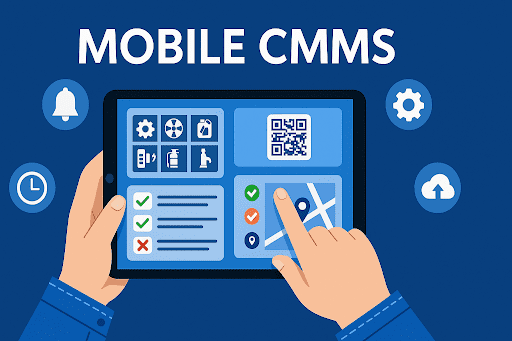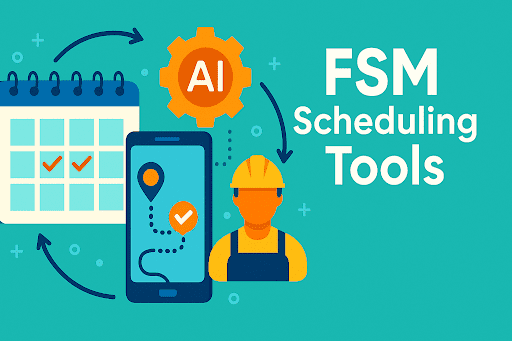 BACK TO Blog
BACK TO Blog
Asset Rental Management
Field Service
Field service organizations must meet escalating requirements to provide faster precise services that address customer needs directly. Real-time updates of work orders represent an optimal method to achieve this goal. Real-time updates help field technicians and managers run smoother operations by speeding up work order responses and delivering enhanced customer experiences in facility maintenance and construction site inspections and utility repairs. A complete guide explains the vital elements
- July 25, 2025
- DreamzCMMS Team
- 12 minutes read

- July 25, 2025
- DreamzCMMS Team
- 12 minutes read
Field service organizations must meet escalating requirements to provide faster precise services that address customer needs directly. Real-time updates of work orders represent an optimal method to achieve this goal. Real-time updates help field technicians and managers run smoother operations by speeding up work order responses and delivering enhanced customer experiences in facility maintenance and construction site inspections and utility repairs.
A complete guide explains the vital elements of real-time work order updates with detailed information about how CMMS for work order tracking and work order management software transform maintenance operations.
Optimize Asset Maintenance with DreamzCMMS
A CMMS platform with automated work order tracking enables organizations to reach peak maintenance performance. Your team will stay informed and asset reliability and downtime reduction will improve.
Learn More – Asset Maintenance Management Software
What Are Real-Time Work Order Updates?
Job-related information flows instantly between field technicians and back-office staff and customers through real-time work order updates. All stakeholders receive instant notifications through the system whenever a work order experiences any change including creation or modification or completion.
Field technicians access mobile work order updates through field apps which allow them to perform real-time on-site task updates. Managers who use live work order notifications maintain full visibility into work order status throughout every stage of the process.
Companies operating multiple service operations should invest in Field Service Management Software for achieving smooth coordination and real-time tracking capabilities.
Why Real-Time Work Order Updates Are Essential for Field Teams
Multiple operational components in field operations become more efficient through real-time updates:
1. Enhanced Maintenance Team Coordination
The connection between field technicians and their supervisors and dispatchers through real-time systems eliminates communication breakdowns to create efficient maintenance operations.
2. Faster Response to Changes
Technicians who receive immediate maintenance dispatch alerts can immediately change their route to handle urgent assignments thus reducing the execution time of tasks.
3. Better Customer Experience
Job status transparency through real-time updates creates trust between customers because they remain aware of ongoing service operations.
4. Optimized Resource Allocation
The digital work order synchronization system enables managers to check technician availability while job assignments are made through location-based and expertise-specific methods which reduces time and resources.
5. Accurate Documentation
Field personnel can swiftly document service information by taking photos and collecting customer signatures for creating accurate real-time service records.
Key Benefits of Real-Time Work Order Updates
The transition from manual work order updates to real-time systems generates quantifiable advantages:
1. Improved Response Time for Work Orders
The combination of automated alert systems with work order communication tools gives technicians immediate access to new and updated jobs thereby shortening their response times.
2. Increased First-Time Fix Rates
Work order management software provides field teams with service history along with troubleshooting guides and spare parts availability which results in better first-visit problem resolution.
3. Better Maintenance Team Coordination
The shared dashboard provides work order status visibility to all team members for smooth collaboration.
4. Cost Savings
The combination of optimized routing and shorter travel times with decreased repeat visits leads to substantial cost reductions while increasing service capacity.
5. Streamlined Maintenance Workflows
The combination of digital work order synchronization with mobile work order update capabilities minimizes paperwork while eliminating manual data entry to allow technicians to concentrate on essential repair tasks.
Facility operations companies achieve better inspection scheduling and compliance tracking as well as resource allocation by integrating Facility Management Software with real-time updates.
How Real-Time Work Order Updates Work
Real-time work order updates require organizations to follow these essential implementation steps:
1. Work Order Creation and Assignment
The back-office team generates work orders through CMMS for work order tracking and FSM tools. The mobile application receives job details at once which includes customer address and required parts together with estimated service time.
2. Live Work Order Notifications
Technicians get immediate work order updates through their mobile apps which allow them to accept jobs or modify their scheduled work.
3. Real-Time Job Status Updates
The system allows field technicians to report their job status through their mobile devices by selecting options such as “en route,” “on-site,” and “completed.” The system displays all site task updates in real time to both management personnel and customers.
4. Digital Work Order Sync
All system updates synchronize automatically which eliminates duplicate entries and data loss.
5. Instant Maintenance Dispatch Alerts
Emergency jobs can be assigned instantly to the closest available technician through dispatch systems which enhances operational flexibility.
Essential Features for Real-Time Work Order Updates
The selection process for work order management software or CMMS demands specific features which are essential for work order tracking functions.
Mobile Work Order Updates
Field teams need mobile access to work orders alongside job status updates which enables smooth maintenance team operations.
Digital Work Order Sync
Automatic synchronization ensures that updated information is instantly available across all devices.
Work Order Communication Tools
Work order status updates become accessible to all stakeholders through built-in messaging tools and voice note functions and customer notification systems.
Instant Maintenance Dispatch Alerts
The system provides immediate job assignment capabilities to select technicians for both emergency and high-priority work orders.
Integration with Inventory Systems
Technicians can complete their tasks more efficiently because real-time inventory checks show the availability of necessary parts.
Challenges in Implementing Real-Time Work Order Updates
The implementation of real-time work order updates provides substantial advantages yet organizations face particular difficulties during this process. Organizations can develop successful prevention strategies when they recognize these challenges beforehand.
1. Connectivity Issues
The implementation of real-time updates depends entirely on continuous internet connectivity. The network coverage in remote rural areas frequently proves insufficient for digital work order synchronization because field teams operate there. Status updates become delayed while job sequences become incorrect and work orders end up duplicated when these conditions occur.
Solutions for mobile work order updates should incorporate offline capabilities to enable technicians to store data locally until their connection restores.
2. Change Management Resistance
The teams who traditionally used paper-based and manual processes will resist adopting work order communication tools as part of their routine work. Field technicians sometimes view mobile applications as additional work that hinders their productivity instead of helping them work more efficiently thus slowing down adoption.
A successful approach to overcome resistance requires clear communication about benefits and early technician involvement during selection and controlled implementation of changes.
3. Training and Skill Gaps
The implementation of CMMS work order tracking systems and mobile applications needs proper training from end users. Technicians without experience of digital tools face difficulties in real-time on-site task update reporting which produces inaccurate or incomplete records.
The solution to build field team confidence involves delivering structured hands-on training alongside user-friendly documentation and ongoing technical assistance.
4. Data Security Concerns
Real-time systems transfer sensitive work order data containing asset information and customer details which remain at risk for unauthorized access or cyberattacks.
The protection of work order status visibility along with other sensitive data requires implementing strong security measures that include end-to-end encryption with secure login systems and scheduled security evaluation procedures.
5. Integration with Legacy Systems
The majority of organizations continue using outdated legacy systems that lack built-in features for immediate maintenance dispatch alerts and digital work order synchronization. The process of connecting new software systems with current infrastructure becomes difficult and expensive.
Best Practices for Successful Implementation
Follow these best practices to ensure success:
Invest in Reliable Work Order Management Software
The system requires a platform which provides real-time job status updates together with immediate maintenance dispatch alerts.
Train Field Teams
The training should focus on providing hands-on experience to enable technicians to use mobile work order updates and digital work order sync features efficiently.
Start with Pilot Programs
A small team should first test the system to discover issues that will become apparent after complete system implementation.
Monitor Performance Metrics
Track KPIs such as response time for work orders, first-time fix rates, and maintenance team coordination improvements.
Check out these additional articles for additional insights on improving field service efficiency:
- Chatbot FSM Tools –Learn how AI-powered chatbots enhance technician communication.
- FSM Feedback System –Discover how structured feedback can boost field service performance.
- FSM Scheduling Tools – Understand how advanced scheduling tools improve resource allocation.
The sales optimization process can benefit from Field Sales Software for field service businesses to improve customer contact and team collaboration.
Role of CMMS and FSM Tools in Work Order Tracking
The current combination of CMMS for work order tracking with Field Service Management (FSM) tools leads to better control of field operations while providing immediate updates on work orders. The combination of scheduling and reporting features with tracking within one system improves operational efficiency while delivering better customer satisfaction.
1. Centralized Database for Complete Visibility
The combination of CMMS or FSM tools integrates work orders together with service history records and spare parts information and technician updates into one platform. The centralized system removes work order status confusion by providing complete visibility to all stakeholders who avoid using scattered spreadsheets or manual logs.
The system enables dispatchers and managers to view live dashboards for work order status updates which helps them direct maintenance teams more effectively and allocate resources better.
2. Automated Scheduling and Dispatch
Modern FSM tools use AI algorithms to automatically match maintenance jobs with the most qualified technician through analysis of location and skill and availability. The instant dispatch alerts for maintenance emergencies decrease response times for urgent work while field teams can complete additional tasks during their workday.
The system notifies qualified technicians in the vicinity immediately when high-priority maintenance requests are logged so work orders can receive faster response times.
3. Real-Time Analytics and Performance Tracking
The analytics features of CMMS platforms enable managers to monitor technician efficiency and track first-time fix rates along with job completion duration in real time. The maintenance needs prediction and recurrent issue detection and streamlined maintenance workflow optimization become possible through data-driven analysis.
Through pattern analysis managers gain better control over preventive maintenance scheduling to prevent unexpected stoppages and achieve better asset reliability.
4. Integration with Mobile Work Order Updates
The majority of contemporary CMMS and FSM systems provide mobile work order updates that enable technicians to make field-based task modifications in real time. The digital work order synchronization process maintains instant field updates to the central system which keeps all teams working with the same information.
5. Improved Customer Communication
The work order communication tools integrated into FSM systems allow customers to receive updates. Automatic job status updates to customers through technician ETA notifications and job progress reports and completion updates create better transparency which results in higher customer satisfaction.
Future of Real-Time Work Order Updates
Field service teams receive modernization of their real-time work order updates through new emerging technologies. The combination of automated systems with predictive data analysis and innovative communication tools will deliver faster services and better technician performance with higher customer contentment in the future. The following developments are anticipated for the future.
1. AI-Powered Predictive Work Orders
Artificial Intelligence (AI) has progressed past basic work order automation tasks. AI systems process equipment history alongside maintenance logs and user patterns to identify equipment failures before they happen. The system generates and assigns predictive maintenance work orders to technicians automatically which minimizes unplanned equipment breakdowns.
AI uses machine learning algorithms to identify unusual machine vibrations which trigger automatic scheduling of technician visits with instant alerts sent to available field workers.
2. IoT-Triggered Alerts for Proactive Maintenance
The integration of Internet of Things (IoT) sensors with CMMS for work order tracking enables real-time updates to reach their highest level. Real-time job status updates are triggered automatically when IoT-enabled assets detect any abnormal readings of temperature pressure or energy consumption.
The system creates work orders automatically through sensors which detect HVAC equipment overheating thus providing maintenance teams with quick alerts for immediate intervention to avoid costly breakdowns.
3. Augmented Reality (AR) Assistance for Technicians
Augmented Reality (AR) technology will revolutionize how technicians complete challenging equipment maintenance tasks. Field workers access interactive 3D overlays along with remote expert instructions and visual troubleshooting guides through AR glasses and mobile applications when performing equipment maintenance.
Technicians who use AR tools can speed up their on-site task updates through real-time reporting while managers gain immediate access to digital work order sync which enables instant instruction addition and spare part requests.
4. Voice-Activated Mobile Work Order Updates
The upcoming implementation of voice recognition technology will eliminate the need for manual typing to modify work orders. Technicians will utilize voice commands for updating work orders and reporting service notes and requesting spare parts which enables quicker mobile work order management while ensuring both safety and hands-free operation in dangerous conditions.
The system will perform automatic status updates when a technician completes work on a generator by giving the command “Work order completed—upload pictures.”
5. Blockchain for Secure Work Order Tracking
The future of work order management software will incorporate blockchain technology which will establish tamper-proof record systems. Every phase of the work order process starting with job creation through completion will become securely documented which protects data integrity and strengthens audit compliance.
6. Enhanced Customer Self-Service Portals
The integration of real-time systems with self-service portals will provide customers with better system visibility. Through self-service portals customers can observe work order status updates and technician arrival times and also authorize extra service requests in real time to enhance their service experience.
Conclusion
Real-time work order updates transform field service operations into a complete game-changer. Organizations that use CMMS for work order tracking alongside mobile work order updates and digital work order synchronization can achieve better maintenance team coordination and faster job completion and improved work order response times.
Organizations should invest in work order management software and streamline maintenance workflows because this approach leads to reduced costs together with improved customer satisfaction and faster task execution.
Streamline Field Service with DreamzCMMS
Your field teams need real-time job status updates combined with instant notifications through DreamzCMMS's work order communication tools. DreamzCMMS provides better maintenance team coordination and faster response times.
Ready for More?
Talk to one of our CMMS experts and see how DreamzCMMS can simplify your maintenance operations.
Book a free consultation




















